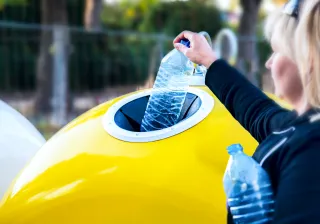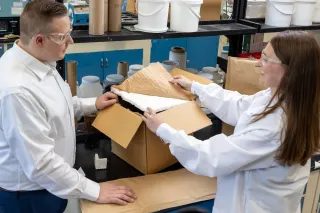Cora Consumer, a European citizen, opens approximately seven packaging containers every day. She produces 157 kg of packaging waste every year, of which almost 20% is plastic. Most of the plastic consumed in Europe is in the form of packaging.
At the same time, more and more plastic is being produced and used. The European Commission and national governments are looking for solutions to the growing problem of plastic pollution and ways to combat climate change. Under the EU’s plastics strategy , single-use plastics will be phased out and all plastic packaging will be recyclable, reusable or compostable by 2030. The EU is also pursuing a significant reduction in carbon dioxide emissions by 2050.
Even if Cora Consumer is still unaware of the EU policies, she can read in her morning paper all about how the oceans are drowning in plastics and how microplastics are taking over water bodies and dinner plates.
The media storm around plastics has also left Cora confused about bioplastics. Is bioplastic bad too? What is true and what is not? Can I still put my biodegradable waste in a compostable food waste bag?
As a consumer and an environmentally conscious person, Cora wants answers. We as experts want to give Cora (and you) facts instead of false and biased claims and to bring about more productive debate.
Claim: Bioplastic is the same as biodegradable plastic
It is not quite as simple as that. Bioplastics are plastics that can be bio-based, biodegradable or both. Not all bioplastics are biodegradable, and not all biodegradable plastics are bio-based. In any case, bioplastics play an important role in achieving the objectives of bioeconomy and a low-carbon society. The EU’s plastics strategy has identified both bio-based and biodegradable plastics as future solutions of the circular economy of plastics.
Claim: Bioplastics are a form of greenwashing
Not quite. Attention has been called to greenhouse gas emissions in many applications. Something can also be done about the emissions resulting from the production of plastics. Instead of fossil raw materials, the main plastics of today can be produced from renewable sources (so-called “drop-in” bioplastics ). Although there is still enough oil left to make plastic for hundreds of years, abandoning fossil raw materials is already an important goal. Not only do bio-based materials reduce our dependence on oil by making use of renewable raw materials and energy in production processes, the resulting carbon dioxide emissions to the atmosphere in plastic production are also lower . Recycling bio-based plastic also makes it possible to achieve a lower carbon footprint than that of recycled oil-based plastic.
Both fossil-based and renewable “drop-in” plastics need to be disposed by incineration when they can no longer be recycled. When plastic waste is incinerated, carbon dioxide emissions are released to the atmosphere. Unlike with bio-based plastic, emissions from oil-based plastic consist of non-renewable fossil carbon, dug from deep inside the ground. New plastic is produced to replace it – either from fossil sources or renewable materials that bind carbon dioxide.
Claim: Bio-based plastics take resources away from food production
Let us put this claim into the right perspective: Yes, bio-based plastics are made from ingredients such as corn and sugarcane. However, only 0.02% of the world’s arable land area is currently used to produce bio-based plastics, and there is no threat of competing with food production in sight . In the future, more use can also be made of biomass waste or forest-based materials, as more and more of these become available thanks to industrial restructuring. A greater threat is the fact that 67% of arable land is used for pasture, i.e. to feed food. There is also still uncultivated land left in the world.
Bio-based barrier films. Source: VTT
Claim: Biodegradable plastics also produce microplastics
No, genuinely biodegradable plastic does not produce microplastics. It breaks down with the help of heat and microorganisms into carbon dioxide (or, in anaerobic conditions, into methane), water and biomass. The degradation rates of different bioplastics vary considerably, and the full decomposition of many biodegradable plastics into water and carbon dioxide requires standardised industrial composting conditions . Although some plastics break down in nature, composting is always recommended, as all kind of littering should be avoided. It is important to remember when designing a biodegradable product that all the components must be biodegradable. Unlike genuinely biodegradable plastics, OXO-biodegradable plastics break down into small particles with the help of additives and contribute to the generation of microplastics. There are plans to ban OXO-biodegradable plastics across the EU.
Claim: Biodegradable plastics should be banned in consumer products
Absolutely not, as biodegradability answers a need. The biggest challenges in recycling plastic are contamination, the wide range of applications and multi-layered structures. Biodegradable materials are specifically designed to reduce plastic waste, and they are the recommended alternative, for example, in cases where recycling is difficult, such as packaging that are multi-layered and contaminated by food. Biodegradable plastics are also seen as useful in “co-benefit” products, such as food waste bags, which both encourage households to recycle their biodegradable waste and protect collection bins to get filthy. Compostable food waste bags are compatible with the biowaste collections of most waste management companies, and some can also be used in home composts. It is nevertheless worth checking local guidelines.
Although biodegradable plastics are designed to be compostable, some of them can also be recycled mechanically . This supports the objectives of the circular economy.
Claim: Bioplastics are of low quality
This is a mistaken generalisation. Plastics are a diverse group of materials the properties of which can be customised for countless applications: this also goes for bio-based and biodegradable plastics, both of which exist in countless different classes and qualities.
The development of bioplastic materials currently focuses on new, non-food-based ingredients, bio-based barrier films and their use in monomaterial applications as well as solutions suitable for home composting. The key objective is even better performance.
One of the most promising new products under development is polyglycolic acid (PGA), which is bio-based, biodegradable and compatible with other biodegradable plastics and has better barrier properties than current products. Current bio-based “drop-in” plastics are about to be joined by high-performance plastics, such as polyethylene furanoate (PEF), which could provide a higher-performance alternative for polyethylene terephthalate (PET), which is used especially in plastic bottles. Its ability to bind carbon dioxide is as much as six times that of PET, and its rigidity makes it suitable for producing considerably lighter recyclable drinks bottles.
From now on, Cora will be able to view news about bioplastics critically: not everything that is written is true. Bioplastics are one of the objectives of the circular economy, and they represent more responsible plastic consumption. In the future, the multi-layer packaging structures will ideally been replaced by bio-based monomaterial solutions or compostable composite materials without sacrificing the most important function of packaging: protecting its contents.








